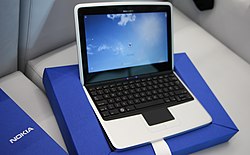 Nokia booklet 3G | |
| Developer | Nokia |
|---|---|
| Type | Netbook |
| Media | Toshiba MK1235GSL 4200rpm 120 GB SATA HDD [1] |
| Operating system | Windows 7 [2] |
| CPU | Intel Atom Z530 1.6 GHz |
| Memory | 1 GB |
| Display | 10.1-inch (260 mm) 1024×600 glossy display |
| Graphics | US15W (GMA 500) [3] |
| Camera | built-in 1.3 megapixel webcam with microphone |
| Connectivity | 3x USB 2.0 ports SD card reader HDMI 1.2 3.5mm headphone jack Wi-Fi 802.11 b/g/n WLAN 3G/HSPA Bluetooth 2.1 A-GPS |
| Power | 12 hours of battery life, AC-200 (19V⎓1,85A) |
| Dimensions | 264 x 185 x 19.9 mm |
| Weight | 1.25 kg (2.8 lb) |
The Nokia Booklet 3G was a netbook produced by the Finnish company Nokia. It was announced on 24 August 2009.